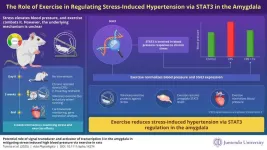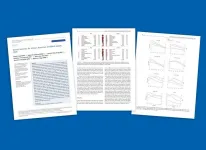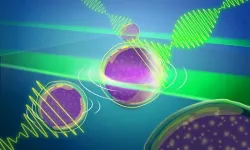(Press-News.org)
Hypertension (high blood pressure) is a debilitating condition and a major cause of premature death worldwide. Chronic stress plays a significant role, but the underlying mechanism involving biochemical pathways by which stress leads to hypertension has not been well understood. Understanding these pathways could lead to the development of therapeutic agents to combat hypertension. Now, a new study from Juntendo University, Japan, led by Professor Hidefumi Waki, Dr. Keisuke Tomita, and Dr. Ko Yamanaka, published online in the journal Acta Physiologica on January 13, 2025, has shown that voluntary exercise prevents stress-induced hypertension through restoration of amygdala signal transducer and activator of transcription 3 (Stat3), a gene that is crucial to the normal function of the amygdala, an almond-shaped part of the brain involved with the experiencing of emotions.
“In the amygdala, the gene Stat3 is involved in the regulation of blood pressure and possibly plays a role in blood pressure elevation in response to chronic stress. It might also be involved in the improvement of stress by voluntary exercise,” explains Prof. Waki while elaborating on the role of STAT3.
The amygdala is a key player in the body’s cardiovascular response. When exposed to prolonged stress, this region triggers an increase in blood pressure, heightening the risk of heart disease. To understand how exercise influences this process, researchers subjected rats to three weeks of chronic stress, with one group engaging in voluntary wheel running. Subsequently, they analyzed blood pressure levels and the levels of various genes using gene expression analysis in the amygdala to identify changes at the molecular level.
The study found that chronic stress led to a marked increase in blood pressure. Moreover, gene expression analysis revealed decreased Stat3 gene expression in the amygdala. However, when stressed rats underwent daily exercise, their blood pressure was normal, and STAT3 levels rebounded.
Subsequent experiments demonstrated that Stat3 expression blockade in the amygdala, in the absence of stress, produced an increase in blood pressure, underlining its important function in cardiovascular control.
“The improvement of cardiovascular dynamics after exercise is attributed to the rescue of Stat3 expression possibly because of mechanisms such as neuroprotection and anti-inflammation,” explains Prof. Waki while elaborating on the underlying mechanism.
The findings of the study highlight a previously unknown brain-based mechanism behind exercise’s ability to combat high blood pressure. While regular physical activity is already recommended for heart health, this study suggests it may also serve as a non-drug therapy for stress-induced hypertension and related conditions like anxiety. However, researchers caution that more studies are needed to confirm these findings in humans and to explore whether therapies targeting STAT3 could offer new treatments for hypertension.
“STAT3 plays a potential role in arterial pressure elevation in response to chronic stress and its improvement through exercise, both of which need to be clarified in future studies,” concludes Prof. Waki.
Next, the team plans to explore whether specific types of exercise—or even pharmacological approaches—can enhance STAT3 activity in the amygdala to offer protection against hypertension.
Overall, their research reinforces a simple yet powerful message: exercise is not just for your body—it’s for your brain too.
Reference
Authors
Keisuke Tomita1, Ko Yamanaka1, Thu Van Nguyen1, Jimmy Kim1, Linh Thuy Pham1, Toru Kobayashi1, Sabine S. Gouraud2, and Hidefumi Waki1
Title of original paper
Potential role of signal transducer and activator of transcription 3 in the amygdala in mitigating stress-induced high blood pressure via exercise in rats
Journal
Acta Physiologica
DOI
10.1111/apha.14274
Affiliations
1Department of Physiology, Graduate
School of Health and Sports Science,
Juntendo University, Japan
2College of Liberal Arts, International
Juntendo University, Japan
About Professor Hidefumi Waki
Dr. Hidefumi Waki is a Dean and Professor at the Graduate School of Health and Sports Science, Juntendo University, Japan. His research focuses on the central mechanisms underlying the antihypertensive effects of exercise training, particularly the role of the nucleus of the solitary tract, the hypothalamic paraventricular nucleus, and the central nucleus of the amygdala in cardiovascular regulation. He has published on neurogenic hypertension and the benefits of regular physical activity in its management. He serves as an Associate Editor for the Japanese Journal of Physical Fitness and Sports Medicine and as Editor for The Journal of Physiological Sciences.
END
A critically endangered species of shark could be forced to adapt to new habitats – or face extinction – as a result of changes in the ocean predicted to occur as a result of climate change, a new study has suggested.
The whitefin swellshark (Cephaloscyllium albipinnum) is a species of catshark found in deeper waters just off Australia’s south and east coasts. Its precise population numbers are uncertain, but the species has been assessed by the International Union for Conservation of Nature (IUCN) as Critically ...
The American Cancer Society (ACS) today released Cancer Statistics for African American and Black People, 2025. According to the report, the cancer mortality rate declined from 1991 to 2022 by 49% and 33% in Black men and women, respectively, in the United States. However, African American and Black people continue to have a disproportionately elevated cancer burden compared to other population groups. According to the study, the risk of cancer death for Black individuals is two-fold that of White individuals for myeloma, prostate, uterine corpus (endometrial), and stomach cancers, and 40%-50% higher for colorectal, ...
Statement Highlights:
Although people with cardiovascular abnormalities have previously been considered ineligible for competitive sports participation, new evidence indicates that athletes of all ages who have certain heart abnormalities or diseases may often safely participate in competitive sports.
A new joint scientific statement from the American Heart Association and the American College of Cardiology emphasizes the need for shared decision-making between athletes and their clinicians, and provides guidance for health care professionals about how to assess risk when considering competitive sports participation for people with various cardiovascular conditions.
More ...
CAMBRIDGE, MA -- RNA splicing is a cellular process that is critical for gene expression. After genes are copied from DNA into messenger RNA, portions of the RNA that don’t code for proteins, called introns, are cut out and the coding portions are spliced back together.
This process is controlled by a large protein-RNA complex called the spliceosome. MIT biologists have now discovered a new layer of regulation that helps to determine which sites on the messenger RNA molecule the spliceosome will target.
The research team discovered ...
Acid reducing medicines from the group of proton pump inhibitors (PPIs) are best-selling drugs that prevent and alleviate stomach problems. PPIs are activated in the acid-producing cells of the stomach, where they block acid production. Researchers at the German Cancer Research Center (DKFZ) made the surprising discovery that zinc-carrying proteins, which are found in all cells, can also activate PPIs – without the presence of gastric acid. The result could be a key to understanding the side effects of PPIs.
Excessive gastric acid can cause not only heartburn, but also chronic complaints such as gastritis or even a stomach ...
A new paper updates an EMBL technology advance even further. More details about the original technology can be found in our initial reporting here.
EMBL tech developers have made an important leap forward with a novel methodology that adds an important microscopy capability to life scientists’ toolbox. The advance represents a 1,000-fold improvement in speed and throughput in Brillouin microscopy and provides a way to view light-sensitive organisms more efficiently.
“We were on a quest to speed up image acquisition,” said Carlo Bevilacqua, lead author on ...
Researchers including those from the University of Tokyo developed Deep Nanometry, an analytical technique combining advanced optical equipment with a noise removal algorithm based on unsupervised deep learning. Deep Nanometry can analyze nanoparticles in medical samples at high speed, making it possible to accurately detect even trace amounts of rare particles. This has proven its potential for detecting extracellular vesicles indicating early signs of colon cancer, and it is hoped that it can be applied to other medical and industrial fields.
Did you know your ...
Toronto, ON - Preteens who spend more time on screens are more likely to develop manic symptoms years two-years later, according to a new study published in Social Psychiatry and Psychiatric Epidemiology.
The findings reveal that 10- to 11-year-olds who engage heavily with social media, video games, texting, and videos show a greater risk of symptoms such as inflated self-esteem, decreased need for sleep, distractibility, rapid speech, racing thoughts, and impulsivity — behaviors characteristic of manic episodes, a key feature of bipolar-spectrum disorders.
“Adolescence is a particularly ...
Fukuoka, Japan—How are stars born, and has it always been this way?
Stars form in regions of space known as stellar nurseries, where high concentrations of gas and dust coalesce to form a baby star. Also called molecular clouds, these regions of space can be massive, spanning hundreds of light-years and forming thousands of stars. And while we know much about the life cycle of a star thanks to advances in technology and observational tools, precise details remain obscure. For example, did stars form this way in the early universe?
Publishing in The Astrophysical Journal, researchers from Kyushu University, in collaboration with Osaka Metropolitan ...
Blood pressure drug could be a safer alternative for treating ADHD symptoms, finds study
Repurposing amlodipine, a commonly used blood pressure medicine, could help manage attention-deficit/ hyperactivity disorder (ADHD) symptoms, according to an international study involving the University of Surrey.
In a study published in Neuropsychopharmacology, researchers tested five potential drugs in rats bred to exhibit ADHD-like symptoms. Among them, only amlodipine, a common blood pressure medication, significantly reduced hyperactivity.
To ...



